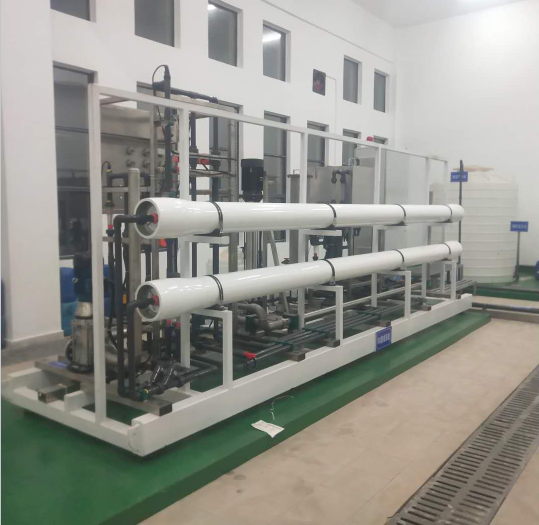Landfill leachate is a kind of organic wastewater with high concentration, which comes from the water contained in the landfill itself, the rain and snow water and other water that enters the landfill, deducts the saturated water holding capacity of the garbage and the overlying soil layer, and goes through the garbage layer and the overlying soil layer.

I. Reverse osmosis membrane treatment technology
Reverse osmosis membrane treatment is a complex membrane separation technique that blocks all dissolved salts and organic matter with a molecular weight of more than 100, but water molecules can pass through. The desalination rate of cellulose acetate membrane is generally more than 95%, and the desalination rate of composite membrane is generally more than 98%. Selective permeability of reverse osmosis membrane is related to dissolution, adsorption and diffusion of components. Therefore, in addition to the pore size of the membrane, it is also closely related to the physical and chemical properties of the membrane, that is, to the interaction between the membrane and its components. Reverse osmosis membrane can be divided into two types: roll membrane (RO) and dish tube membrane (DTRO). The inlet water quality of the film is relatively high, usually requiring UF or NF as the pretreatment process, so that SDI is less than 5, suspended matter is less than 5mg/ L, to prevent membrane pollution; DTRO membrane process is based on the dish tube reverse osmosis membrane. The core technology of the process is the unique structure of the dish tube reverse osmosis membrane, which makes it possible to use the reverse osmosis membrane to treat landfill leachate directly.
DTRO membrane technology is a dish tube membrane technology, divided into two categories :DTRO(dish tube reverse osmosis) and DTNF(dish tube nanofiltration). It is a patent membrane separation equipment. The technology has been developed specifically for leachate treatment. The structure of membrane assembly is completely different from that of traditional roll membrane. Concentrate channels: plate membrane module with a form of the design patent, Zhang Kailiu, liquid through population into the pressure vessel, from the passage between the baffle and the shell on the other side of the assembly, the other end of flange, material liquid into the deflector by 8 channel, the shortest distance and treatment liquid flow rapidly through the filter membrane, then reverse the 180 ° other membrane surface, and then from the geometric center of the slot to the next guide plate, thus forming from the circumference of the guide plate to the center of the membrane on the surface of a round circle. , and then to the circumferential direction, to the center of the double "S" shaped route, the concentrate finally flows out of the feed end flange. The distance between the two deflectors of the DT assembly is 4mm, and the surface of the deflectors is arranged with certain raised points. This special hydraulic design makes the treatment liquid under the pressure of the surface of the filter membrane, in the collision form turbulence, improve the transmission rate and self-cleaning function, thus effectively avoiding the membrane blockage and concentration polarization, successfully prolongs the service life of the diaphragm; When cleaning, it is easy to clean the scale on the diaphragm, so as to ensure that the coil membrane group is suitable for the treatment of high turbidity and high sand-containing sewage and adapt to more severe water inlet conditions.
2. Take a power plant project as an example. The leachate yield of this project is 600m3/d, and the "biochemical treatment + UF+DTRO" treatment scheme is designed.
Introduction of DTRO equipment system process
The effluent from the ultrafiltration system enters the DTRO membrane tower after being filtered by the filter core. A high pressure pump and shock absorber are arranged in front of the DTRO membrane column. The high pressure pump provides sufficient pressure for the DTRO membrane and the shock absorber enables the back-end DTRO. The membrane column can obtain a relatively stable pressure. In addition, in order to ensure the surface flow of the DTRO membrane, part of the DTRO membrane concentrate is returned to the inlet of the membrane column, and then enters the DTRO membrane column through the action of the in-line booster pump. The DTRO membrane column thickener is equipped with a pressure regulating valve to control the pressure in the membrane pack to achieve the necessary water purification rate. The concentrate produced by the system is pushed into the concentrate collecting tank.
The flow sensor and conductivity meter are installed in the inlet and outlet pipes of the system to monitor the flow and conductivity of incoming and produced water. The pressure sensor is installed in each link of circulating pump, high pressure plunger pump, membrane circulating pipeline, liquid cleaning pipeline and concentration pipeline to monitor the pressure of each link. Equipped with pH sensors and temperature sensors for real-time monitoring of changes and concentration of supernatant. Each tank or tank is provided with a liquid level switch to monitor the liquid level; The liquid level meter is set in the important container to monitor the liquid level.
Estimation of pollutant removal rate of DTRO equipment system
According to the current operation data of the leachate treatment system in a power plant, the influent water quality parameters of the system are :CODCr40000~ 7000mg /L, BODS 2000-35000mg /L, ammonia nitrogen 1000-1500mg /L,SS 10000-15000mg/L, PH5 ~7; Inlet water quality parameters of DTRO membrane system: CODCr ≤ LOOOOMG /L, BODS ≤200mg/L, ammonia nitrogen ≤50mg/L, SS≤ LOOMG /L, pH 6~9; System effluent water quality parameters: CODCr ≤ 1OOMg /L, BOD5≤20mg/L, ammonia nitrogen ≤15mg/L, SS≤70mg/L, pH 6~9. From the above data, it can be seen that the DTRO membrane can remove 98% CODCr, 50% ammonia nitrogen, 75-80% suspended matter and 96% salt. Among them, the removal rate of COD and salt is particularly significant.